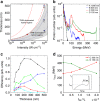Near-100 MeV protons via a laser-driven transparency-enhanced hybrid acceleration scheme
- PMID: 29463872
- PMCID: PMC5820283
- DOI: 10.1038/s41467-018-03063-9
Near-100 MeV protons via a laser-driven transparency-enhanced hybrid acceleration scheme
Abstract
The range of potential applications of compact laser-plasma ion sources motivates the development of new acceleration schemes to increase achievable ion energies and conversion efficiencies. Whilst the evolving nature of laser-plasma interactions can limit the effectiveness of individual acceleration mechanisms, it can also enable the development of hybrid schemes, allowing additional degrees of control on the properties of the resulting ion beam. Here we report on an experimental demonstration of efficient proton acceleration to energies exceeding 94 MeV via a hybrid scheme of radiation pressure-sheath acceleration in an ultrathin foil irradiated by a linearly polarised laser pulse. This occurs via a double-peaked electrostatic field structure, which, at an optimum foil thickness, is significantly enhanced by relativistic transparency and an associated jet of super-thermal electrons. The range of parameters over which this hybrid scenario occurs is discussed and implications for ion acceleration driven by next-generation, multi-petawatt laser facilities are explored.
Conflict of interest statement
he authors declare no competing financial interests.
Figures









References
-
- Macchi A, Borghesi M, Passoni M. Ion acceleration by superintense laser-plasma interaction. Rev. Mod. Phys. 2013;85:751–793. doi: 10.1103/RevModPhys.85.751. - DOI
-
- Borghesi M, et al. Electric field detection in laser-plasma interaction experiments via the proton imaging technique. Phys. Plasmas. 2002;9:2214–2220. doi: 10.1063/1.1459457. - DOI
Publication types
LinkOut - more resources
Full Text Sources
Other Literature Sources

